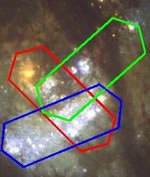
Image credit: Hubble
An international team of astronomers have gathered new evidence to support the “domino theory” of star formation; that star formation occurs in sequence in galaxies driven by the movements of gas and stars at the core. A new instrument attached to the 8m Gemini South Telescope, called CIRPASS, allowed the astronomers to measure the composition of a whole range of stars at the centre of galaxy M83. A detailed analysis of the data is now underway.
An international team of astronomers have used a unique instrument on the 8m Gemini South Telescope to determine the ages of stars across the central region of the barred spiral galaxy, M83. Preliminary results provide the first hints of a domino model of star formation where star formation occurs in a time sequence, driven by the movements of gas and stars in the central bar.
The new instrument, called CIRPASS, simultaneously produces 500 spectra, taken from across the whole region of interest, which act as a series of ‘fingerprints’. Encoded in these ‘fingerprints’ is not only all the information the team required to determine when individual groups of stars formed, but also information on their movements and chemical properties. Dr. Johan Knapen, project co-investigator, ‘The unique combination of a state-of-the-art instrument like CIRPASS with one of the most powerful telescopes available is now providing us with truly sensational observations.’
M83 is a grand design spiral galaxy undergoing an intense burst of star formation in its central bar region. Large scale images, of the visible light from the galaxy, taken with ground based telescopes, show a pronounced bar across the middle of the galaxy) seen as the diagonal white structure in figure 1 . Astronomers believe that it is the influence of this bar which leads a concentration of gas in the central regions of the galaxy from which stars are born. ‘The central region of M83 is enshrouded in dust, but by using CIRPASS, which operates in the infra-red not the visible, we are able to see through this dust and investigate the hidden physical processes at work in the galaxy,’ said Dr Ian Parry, leader of the CIRPASS instrumentation team.
Two competing theories strive to explain the burst of star formation in the centre of the galaxy, M83. One theory suggests that stars form randomly across the whole nuclear region. A second model, favoured by the observational team, proposes that star-formation is triggered by the bar structure. In this model, the rotation of gas and stars in the bar causes stars to be formed sequentially, in a domino manner.
Using a technique first demonstrated by Dr. Stuart Ryder and colleagues, the team searched for a hydrogen emission feature, the Paschen-beta line, within the galaxy’s ‘fingerprints’. The measurement of this feature indicates the presence of hot young stars. By comparing the strengths of the Paschen-beta emission with the amount of absorption from carbon-monoxide (arising in the cool atmospheres of old giant stars) the team are able determine the age of the stars in each region of the galaxy. ‘A detailed analysis of the data is underway but initial results hint at a complex sequence of star formation,’ said Dr Robert Sharp, instrument support scientist with CIRPASS.
Preliminary analysis of other emission features (due to Paschen-beta and ionized iron) revealed a potentially intriguing result. ‘Ionized iron enables us to trace past supernova explosions. The observations indicate that energy from exploding stars (supernovae) may be being passed into regions of undisturbed gas causing further massive star formation.’ said Dr. Stuart Ryder, principle investigator.
While some members of the instrument team are presenting their work at the Royal Society Science Exhibition in London, CIRPASS is back on the Gemini South Telescope in Chile, performing the next set of observations.
Original Source: Cambridge News Release




